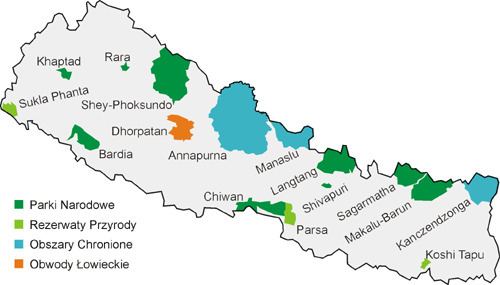 | ||
The protected areas of Nepal cover mainly forested land and are located at various altitudes in the Terai, in the foothills of the Himalayas and in the mountains, thus encompassing a multitude of landscapes and preserving a vast biodiversity in the Palearctic and Indomalayan ecozones. Nepal covers 147,181 km2 (56,827 sq mi) in the central part of the Himalayas. Altitudes range from 67 m (220 ft) in the south-eastern Terai to 8,848 m (29,029 ft) at Sagarmatha within a short horizontal span. This extreme altitudinal gradient has resulted in 11 bio-climatic zones ranging from lower tropical below 500 m (1,600 ft) to nival above 5,000 m (16,000 ft) in the High Himalayas, encompassing nine terrestrial ecoregions with 36 vegetation types. Botanists recorded 1,120 species of non-flowering plants and 5,160 species of flowering plants. Nepal ranks 10th in terms of richest flowering plant diversity in Asia. Zoologists recorded 181 mammal species, 844 bird species, 100 reptile species, 43 amphibian species, 185 freshwater fish species, and 635 butterfly species. In recognition of the magnitude of biodiversity the Government of Nepal has established a network of 20 protected areas since 1973, consisting of ten national parks, three wildlife reserves, six conservation areas and one hunting reserve. In 2017, the Shuklaphanta Wildlife Reserve was upgraded to a national park.
Contents
Additionally, nine Ramsar sites were declared between 1988 and 2008.
National parks
Wildlife reserves
Conservation areas
Hunting Reserve
Ramsar Sites
The following Ramsar sites were declared between 1988 and 2008:
